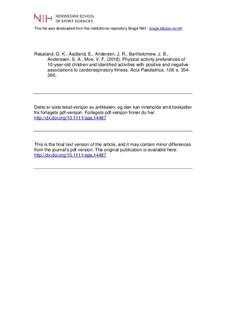| dc.contributor.author | Resaland, Geir Kåre | |
| dc.contributor.author | Aadland, Eivind | |
| dc.contributor.author | Andersen, John Roger | |
| dc.contributor.author | Bartholomew, J.B. | |
| dc.contributor.author | Anderssen, Sigmund Alfred | |
| dc.contributor.author | Moe, Vegard Fusche | |
| dc.date.accessioned | 2019-08-14T09:26:14Z | |
| dc.date.available | 2019-08-14T09:26:14Z | |
| dc.date.created | 2018-09-27T12:50:17Z | |
| dc.date.issued | 2019 | |
| dc.identifier.citation | Acta Paediatrica. 2019, 108 (2), 354-360. | nb_NO |
| dc.identifier.issn | 0803-5253 | |
| dc.identifier.uri | http://hdl.handle.net/11250/2608249 | |
| dc.description | I Brage finner du siste tekst-versjon av artikkelen, og den kan inneholde ubetydelige forskjeller fra forlagets pdf-versjon. Forlagets pdf-versjon finner du på onlinelibrary.wiley.com / In Brage you'll find the final text version of the article, and it may contain insignificant differences from the journal's pdf version. The definitive version is available at onlinelibrary.wiley.com | nb_NO |
| dc.description.abstract | Aim: This study investigated children's physical activity (PA) preferences, as these can aid the design of school‐based interventions. Methods: Data were collected in 2014 as a part of the Active Smarter Kids study and 1026 students (52% boys) from 57 Norwegian primary schools completed a questionnaire about their favourite physical activities at a mean age of 10.2 ± 0.3 years. We identified five patterns of PA and studied whether gender, cardiorespiratory fitness and abdominal adiposity were associated with these patterns. Results: Soccer and slalom skiing were the favourite activities, and the most pronounced gender differences were for activities favoured by girls, which included dancing, gymnastics, exercising to music and jumping rope (p < 0.001). When the five component patterns were analysed using linear mixed‐effect models, this showed a strong female preference for dancing, gymnastics, exercising to music and climbing. Cardiovascular fitness was negatively associated with frisbee, dodgeball, baseball and floorball, and positively associated with team handball, volleyball and basketball and with slalom skiing and cross‐country skiing. It was interesting that the children's preferences were not related to their abdominal adiposity. Conclusion: The results showed different gender‐based PA preferences and positive and negative associations with cardiovascular fitness, but no relationship with abdominal adiposity. | nb_NO |
| dc.language.iso | eng | nb_NO |
| dc.relation.uri | https://rdcu.be/bbGwm | |
| dc.subject | abdominal adiposity | nb_NO |
| dc.subject | cardiorespiratory fitness | nb_NO |
| dc.subject | children | nb_NO |
| dc.subject | gender | nb_NO |
| dc.subject | physical activity | nb_NO |
| dc.title | Physical activity preferences of 10‐year‐old children and identified activities with positive and negative associations to cardiorespiratory fitness | nb_NO |
| dc.type | Journal article | nb_NO |
| dc.type | Peer reviewed | nb_NO |
| dc.description.version | acceptedVersion | nb_NO |
| dc.source.pagenumber | 354-360 | nb_NO |
| dc.source.volume | 108 | nb_NO |
| dc.source.journal | Acta Paediatrica | nb_NO |
| dc.source.issue | 2 | nb_NO |
| dc.identifier.doi | 10.1111/apa.14487 | |
| dc.identifier.cristin | 1614809 | |
| dc.description.localcode | Seksjon for idrettsmedisinske fag / Department of Sports Medicine | nb_NO |
| cristin.unitcode | 150,34,0,0 | |
| cristin.unitname | Seksjon for idrettsmedisinske fag | |
| cristin.ispublished | true | |
| cristin.fulltext | postprint | |
| cristin.qualitycode | 1 | |
